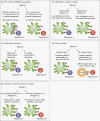Regulation of CD4 T-cell receptor diversity by vaccine adjuvants
- PMID: 20331477
- PMCID: PMC2855789
- DOI: 10.1111/j.1365-2567.2010.03265.x
Regulation of CD4 T-cell receptor diversity by vaccine adjuvants
Abstract
New vaccines based on soluble recombinant antigens (Ags) require adjuvants to elicit long-lasting protective humoral and cellular immunity. Despite the importance of CD4 T helper cells for the generation of long-lived memory B and CD8 T cells, the impact of adjuvants on CD4 T-cell responses is still poorly understood. Adjuvants are known to promote dendritic cell (DC) maturation and migration to secondary lymphoid organs where they present foreign peptides bound to class II major histocompatibility complex molecules (pMHCII) to naïve CD4 T cells. Random and imprecise rearrangements of genetic elements during thymic development ensure that a vast amount of T-cell receptors (TCRs) are present in the naïve CD4 T-cell repertoire. Ag-specific CD4 T cells are selected from this vast pre-immune repertoire based on the affinity of their TCR for pMHCII. Here, we review the evidence demonstrating a link between the adjuvant and the specificity and clonotypic diversity of the CD4 T-cell response, and consider the potential mechanisms at play.
Figures


Similar articles
-
Naive CD4(+) T cell frequency varies for different epitopes and predicts repertoire diversity and response magnitude.Immunity. 2007 Aug;27(2):203-13. doi: 10.1016/j.immuni.2007.07.007. Epub 2007 Aug 16. Immunity. 2007. PMID: 17707129 Free PMC article.
-
Functional evidence for TCR-intrinsic specificity for MHCII.Proc Natl Acad Sci U S A. 2016 Mar 15;113(11):3000-5. doi: 10.1073/pnas.1518499113. Epub 2016 Feb 1. Proc Natl Acad Sci U S A. 2016. PMID: 26831112 Free PMC article.
-
Host DNA released in response to aluminum adjuvant enhances MHC class II-mediated antigen presentation and prolongs CD4 T-cell interactions with dendritic cells.Proc Natl Acad Sci U S A. 2013 Mar 19;110(12):E1122-31. doi: 10.1073/pnas.1300392110. Epub 2013 Feb 27. Proc Natl Acad Sci U S A. 2013. PMID: 23447566 Free PMC article.
-
Modulation of CD4 T cell function by soluble MHC II-peptide chimeras.Int Rev Immunol. 2001 Oct;20(5):547-73. doi: 10.3109/08830180109045578. Int Rev Immunol. 2001. PMID: 11890612 Review.
-
Adjuvants Enhancing Cross-Presentation by Dendritic Cells: The Key to More Effective Vaccines?Front Immunol. 2018 Dec 13;9:2874. doi: 10.3389/fimmu.2018.02874. eCollection 2018. Front Immunol. 2018. PMID: 30619259 Free PMC article. Review.
Cited by
-
How do adjuvants enhance immune responses?Elife. 2024 Aug 13;13:e101259. doi: 10.7554/eLife.101259. Elife. 2024. PMID: 39136115 Free PMC article.
-
The role of the IL-12 cytokine family in directing T-cell responses in oral candidosis.Clin Dev Immunol. 2011;2011:697340. doi: 10.1155/2011/697340. Epub 2010 Oct 24. Clin Dev Immunol. 2011. PMID: 20981280 Free PMC article. Review.
-
Monitoring the Dynamics of T Cell Clonal Diversity Using Recombinant Peptide:MHC Technology.Front Immunol. 2013 Jul 3;4:170. doi: 10.3389/fimmu.2013.00170. eCollection 2013. Front Immunol. 2013. PMID: 23840195 Free PMC article.
-
Pneumococcal conjugate vaccination at birth in a high-risk setting: no evidence for neonatal T-cell tolerance.Vaccine. 2011 Jul 26;29(33):5414-20. doi: 10.1016/j.vaccine.2011.05.065. Epub 2011 Jun 7. Vaccine. 2011. PMID: 21645573 Free PMC article. Clinical Trial.
-
Adjuvants in the Driver's Seat: How Magnitude, Type, Fine Specificity and Longevity of Immune Responses Are Driven by Distinct Classes of Immune Potentiators.Vaccines (Basel). 2014 Apr 10;2(2):252-96. doi: 10.3390/vaccines2020252. Vaccines (Basel). 2014. PMID: 26344620 Free PMC article. Review.
References
-
- Seder RA, Ahmed R. Similarities and differences in CD4(+) and CD8(+) effector and memory T cell generation. Nat Immunol. 2003;4:835–42. - PubMed
-
- McHeyzer-Williams LJ, Malherbe LP, McHeyzer-Williams MG. Helper T cell-regulated B cell immunity. Curr Top Microbiol Immunol. 2006;311:59–83. - PubMed
-
- Davis MM, Boniface JJ, Reich Z, Lyons D, Hampl J, Arden B, Chien YH. Ligand recognition by alpha beta T cell receptors. Annu Rev Immunol. 1998;16:523–44. - PubMed
-
- Malherbe L, Hausl C, Teyton L, McHeyzer-Williams MG. Clonal selection of helper T cells is determined by an affinity threshold with no further skewing of TCR binding properties. Immunity. 2004;21:669–79. - PubMed
Publication types
MeSH terms
Substances
Grants and funding
LinkOut - more resources
Full Text Sources
Medical
Research Materials

